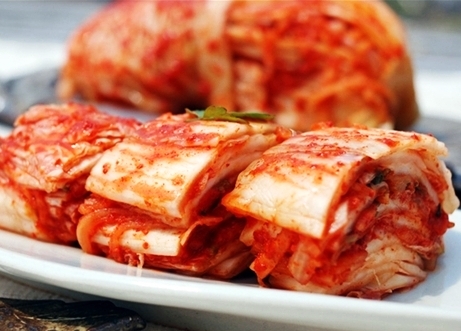
How to Ripen Kimchi
Everyone has a different preference as to when Kimchi(김치) tastes the best – some love eating freshly made, raw kimchi (kind of tastes like a salad); some love eating it when it is just perfectly ripe and then there are those who love sour kimchi (신김치 shin kimchi) which has basically over fermented and obviously tastes quite sour. But one thing is for sure – no one likes the stage when it is in the in-between stages of being raw and ripe. Kimchi really does not taste good at all when it is in the process of getting ripe – I had an aunt who used to call this the time when kimchi has gone CRAZY! And you certainly don’t want to eat the kimchi when it’s crazy! 🙂 So here’s how to ripen Kimchi and avoid CRAZY kimchi.
Since most of us now buy kimchi from the store, let me first write about the best way to eat a store bought kimchi. Too often, I hear people say that the kimchi served at our house tastes great, but when they try the same brand themselves, they think it doesn’t taste nearly as good. I realized it was because they don’t take the time to ripen it properly and then also forget to serve it cold (right out of the fridge). I found that most kimchi (even the poorly made ones) will taste quite palatable when they have had time to ripen properly.
Now, the hard part about buying kimchi from a store is that it is hard to tell at what stage of the fermentation process they are in. One clue is the appearance of the vegetables. They will look more shriveled up if they are further along in the fermentation process. And the chances are that it will also have lost a bit of the juice because the content will start to bubble and balloon up when it ferments which ends up usually overflowing out of the jar. This is actually too bad because kimchi should always be immersed in its own juices for it to taste the best.
The best way is to buy the freshest kimchi possible and bring it home and ripen it from the beginning. But this is usually not possible…So far, I have found the best tasting kimchi that you can buy are actually the ones that are directly imported from Korea (종가집Jongajip is my favorite). It is expensive but worth it in my opinion as long as it hasn’t traveled too far or stayed on the shelf too long at your store. Other than that, the next best thing is to try to buy kimchi that is made locally if it’s available (less chance of it over ripening) and when you bring it home, open it, smell it or better yet, taste it. If your store has a fast turnaround, it is probably in the “crazy” stage.
If it’s already fully ripe, put it in the fridge in the coldest possible setting. If it’s not yet fully ripened and you can wait, let it ripen in your fridge. This will take about 2 weeks in your fridge. Also note that the juice may overflow so either move the kimchi into a bigger container or take some out (1/5th) and leave some room for the kimchi to expand. If your kimchi is still very fresh, not at all ripe and you need to eat it quickly, you can ferment it at room temperature.
In the summer, Kimchi will ripen in 12 ~ 18 hrs and in cooler weather it can take about 24 – 48 hrs. Just check every 4-6 hrs.
If this is all too much info for you to digest, I have a chart at the bottom of this post that can help you with the process. (Boy, it’s been ages since I drew up a flowchart…brings back memories from my college days of hand drawing the charts using graphic rulers..)
What is the ultimate best way to ripen or ferment kimchi?
The most delicious and fantastic kimchi is made when it is fermented the old fashioned way…In a traditional Korean clay jar, buried in the ground in winter time. Even though the ground freezes in the winter, the jar and the saltiness of the kimchi keep it from freezing completely. This is called 김장김치 (kimjang kimchi). Kimjang kimchi is usually made around the ‘start of winter’ (입동 ipdong) in the lunar calendar which is just about now (Nov 7-8th in Gregorian calendar).
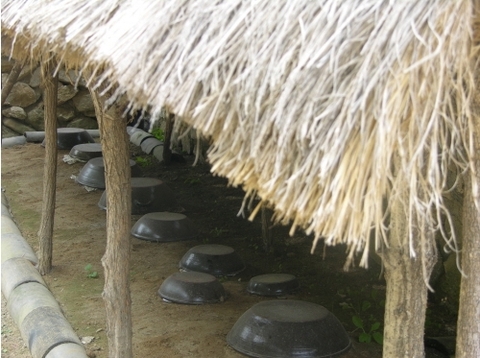
I remember when I was a kid, we spent days preparing and making kimjang kimchi so that it could last us through the winter and into spring. We first dug big holes in the ground big enough to hold our huge clay jars (so big that a child can fall in). In the meantime, we spent the day washing and brining 100+ napa cabbages and also preparing the ingredients for the stuffing. The next day we took these salted napa cabbages and inserted the stuffing in between each cabbage leaf. It was an enormous amount of work but boy…was it worth it. All winter long, we got to eat these amazingly crunchy and zingy and sometimes even ever so slightly frozen kimchi that came out of these jars in the ground. So why was it so tasty?
According to research, when it is buried in the ground, the temperature remains quite constant – at 32 – 35 F all winter long. At this temperature it takes about 20 days for the kimchi to fully ripen but it is definitely worth the wait.
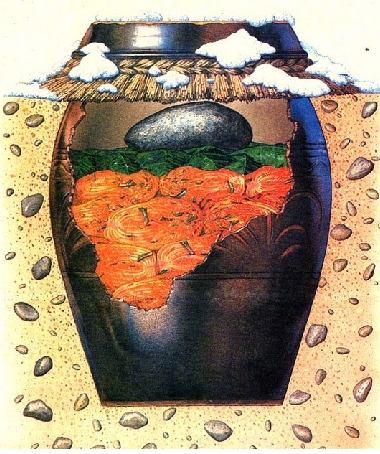
The clay jars are glazed to hold the moisture in but it can still breathe which allows just the right amount of air circulation to take away any heat produced from the fermentation (keeping the temperature stable). It also keeps the air tight enough for the bacteria to not grow too fast which helps the kimchi maintain its peak flavor for a longer period. The history of kimchi can be dated back almost 2000 years to the Goguryo Dynasty according to some historians, so you can see how long Koreans had time to refine the technique of kimchi making.
Since most Koreans now live in apartments and have no backyards to bury the jars, they have invented what is called a kimchi refrigerator. This fridge is different from the conventional refrigerator because the interior walls of the fridge are cooled instead of the air which helps to keep the interior at a more constant temperature. I own one and I have to say it is the next best thing to having your own kimchi jar in the ground. It even has temperature options for fermenting and then just storing it to prolong its freshness.
How to tell if Kimchi is ripe and ready to eat?
When a kimchi is not fully ripe, you are able to smell and kind of taste the individual ingredients – garlic, cabbage, radish, green onion, fish sauce, etc – as they have yet to fully integrate with each other. When it is fully ripened, the tastes of all the ingredients are well blended together and there is full flavor embedded in each cabbage leaf or vegetable pieces. There is also a slight sour taste with an added zing at the end. You can also no longer smell the raw ingredients individually but rather have a combined, wonderful slightly stinky smell that is unique to kimchi. Below is the chart that I promised earlier –
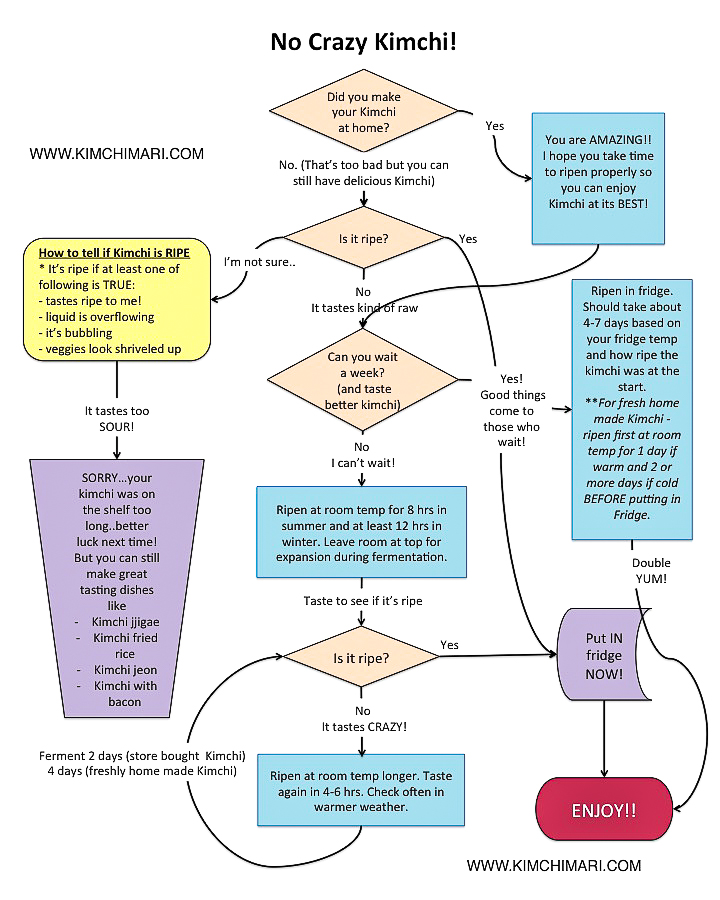
So how long can I store Kimchi in the fridge?
When stored at the ideal temperature that’s close to the freezing point of 32 F (-1 to 0℃), kimchi will keep for 3 months or more.
If the temperature of your fridge is higher (which is normally the case), it will probably keep for at least a month or more. Kimchi will start to taste just too sour when it starts to go bad – at which point, the best way to eat them is by cooking them by making Kimchi Jjigae, Budae Jjigae, Kimchi soft tofu stew, Kimchi fried rice and of course Kimchi Mari! Kimchi will sometimes go bad – it will have this whitish kind of film when it has been really too long and will also smell very pungently sour. You don’t want to eat it at this stage.
Can I take my Kimchi out from the refrigerator and leave it on the counter again to ripen further?
YES! Whether you have store-bought kimchi or made your own kimchi, you can take Kimchi out of the refrigerator at any time and let it ripen or sour further.
If it’s not ripe enough, it will take a long time to ripen in the fridge.
The whole point about my flow chart above was for people who have store-bought Kimchi. You may think it’s ready to eat because you got it from the store, but many times they are not fully ripe and therefore doesn’t taste as good.
Well, I hope this was helpful. Please share this info so that more people can learn how to ripen Kimchi properly and enjoy it at its best!
Take care,
XOXO
JinJoo
PS – if you want to learn more about Kimjang, here are two posts that teach you all about it!
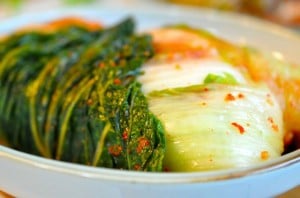 kimjang kimchi
kimjang kimchi- Kimjang Day: Part 1- How it’s done – I share my experiences and tips learned while doing Kimjang with my mother-in-law.
- Kimjang Day: Part 2 – Ingredients and Tips

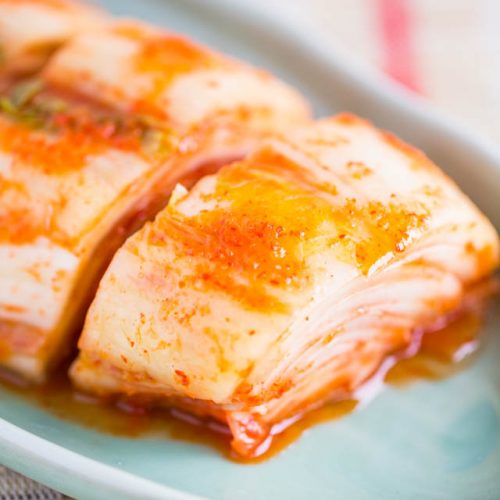
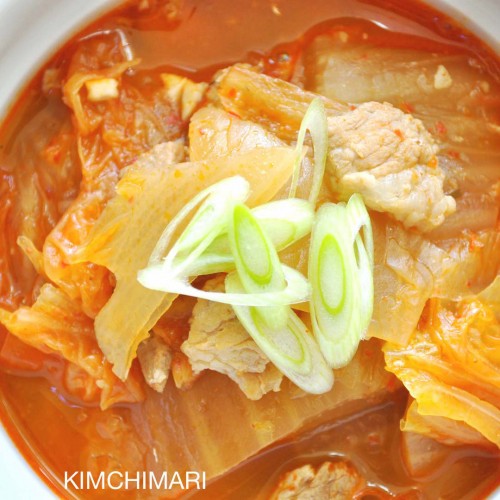
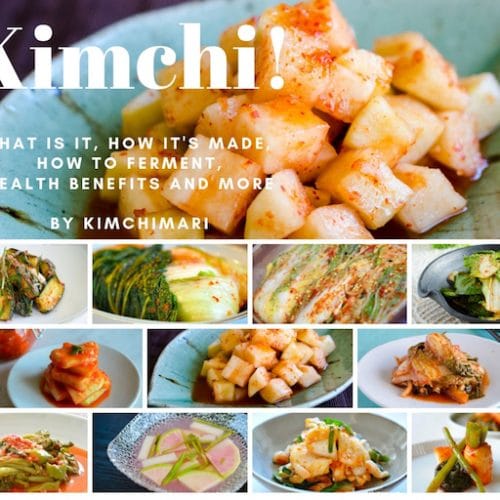
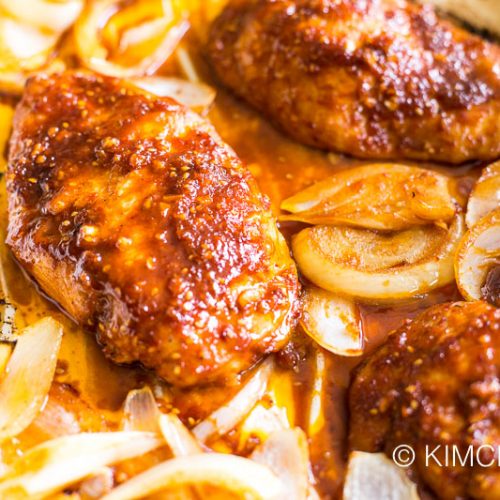
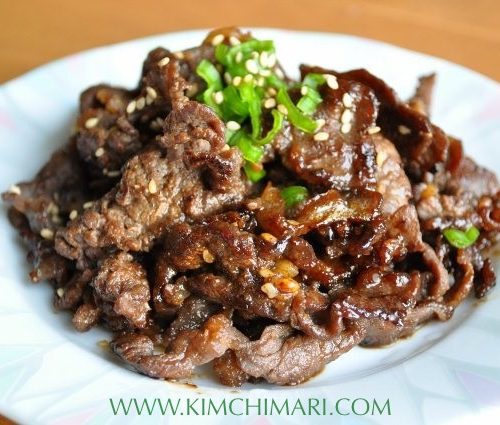
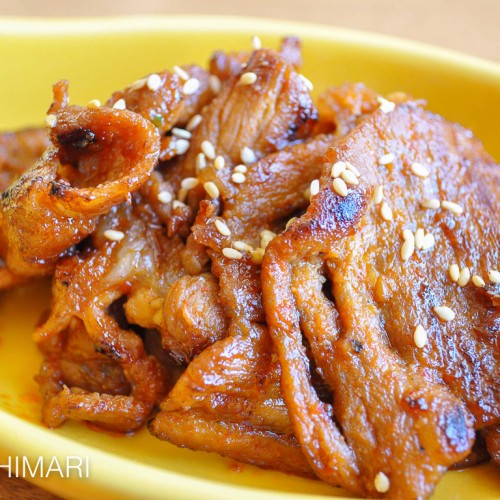
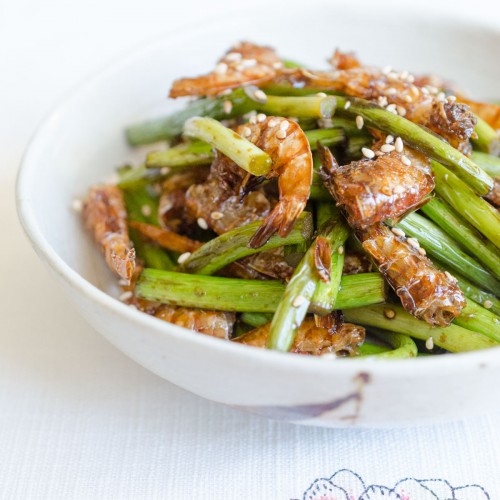
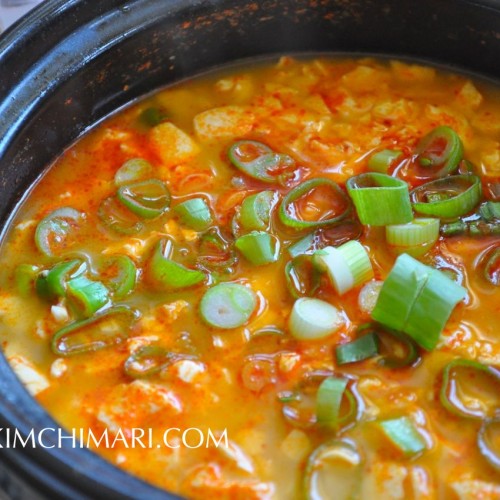
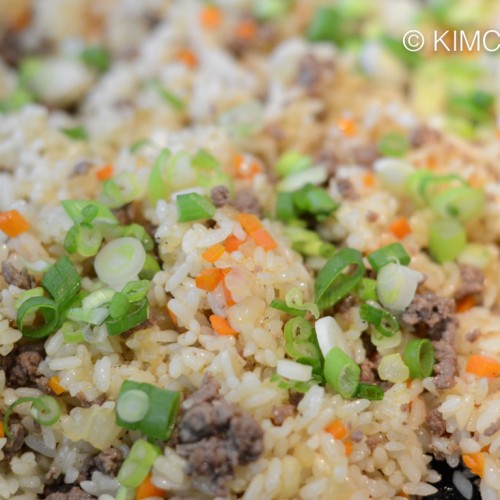

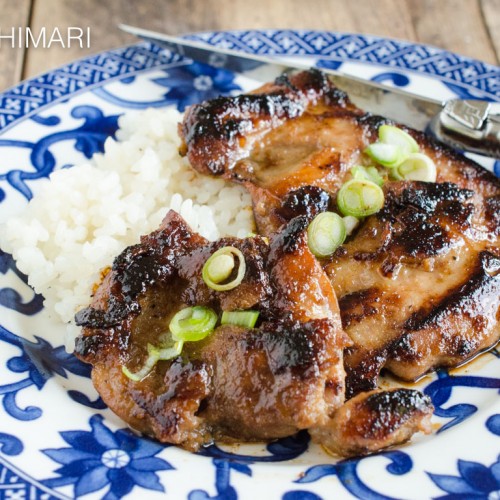








I love the kimchi flowchart and it was very helpful. I recently started eating kimchi and enjoy it very much. I recently just purchased a large jar from a Korean market and while it is overflowing and bubbling, the different ingredients still do not seem to have a uniform taste and the cabbage is a bit hard still. I believe the market i purchased it from sells a lot of kimchi so i am guessing that it just needs some time to ferment and i just left it in the fridge and will be tasting it daily until it gets a bit more uniform and the cabbage has time to do ripen and sour a bit more. Thank you again as i have found this webpage very helpful and appreciate it very much.
HI Vinnie, Thank you so much! So glad you found my Kimchi chart helpful. You are doing the right thing by keeping it in the fridge. If you find that it is taking too long, you can always take it out and leave at room temp for few hours and see how the flavor changes. The texture however should remain still crunchy. If it taste very soft and mushy then it’s actually not in the best state. Still edible just not in its prime state. Good luck!
Dear JinJoo:
I have seen that one of the ingredients to make Kimchee is Korean sweet rice flour… I live in the Philippines, and have trouble locating the flour, even on the internet… Does your store carry the sweet rice flour, or can you refer me to a place that has this sweet rice flour? I appreciate it, and thank you in advance..
Bruce
So if you can’t get it you can also just use regular sweet rice. Just make a thick congee paste out of it – can use blender to grind it before cooking. Sometimes you can even just mix cooked sweet rice. It will dissolve over time. You can also use regular rice flour too. I don’t yet have it on my store but will add it soon. Thank you!
Hi JinJoo,
There is very little information on the interwebs about the specifics of how kimchi refrigerators work, temperatures, etc. I have done extensive research and I can’t find a kimchi refrigerator that fits our space and esthetic. (Danish modern architectural style, 28″ of width at the entrance to our breakfast nook across from the main refrigerator. We also want to keep our rice pot on the counter above the refrigerator.)
So I’m trying to get a functional equivalent to kimchi refrigerators using a U-line with digital thermostat. Would you just recommend keeping it at the lowest possible temperature? They go down to 35 F.
Thanks!
Hi David, thank you for asking. So some actually like to convert a deep freezer to keep the temperature around freezing – 32 F or so. Which is the best temperature to store kimchi for a longer period of time. But if you want to use a refrigerator, keep it at the lowest temperature of 35 F would work too. It’s just that your kimchi will ferment/ripen quicker than at 32 F. Hope that helps, let me know if you have more questions. thanks!
Thank you for responding! Freezers! Brilliant idea. So… I looked into U-line’s freezers, they have a freezer temp range of -5 to 5 F, which would freeze the kimchi completely. The cheaper model is convertible to a refrigerator with a range of 34-45, the same range as their digital thermostat refrigerators.
So we may just have to set our new “kimchi” fridge to 34 F (1.1 °C) and eat our kimchi a little faster than you do. And I love kimchi chigae anyway. 🙂 OTOH, we currently keep our kimchi in our main fridge which stays at 40-45 F, so 34 F is still a HUGE upgrade from that. (And we’ve got to do better about not leaving the kimchi out of the fridge during meals!)
On another note, my mom told me years ago that kimchi placed straight in the fridge without leaving out to ferment gets bitter, so for years we’ve left kimchi out 2-3 days until it gets 익었어. Recently my wife’s 고모 has been staying with us and told us you MUST ferment kimchi in the refrigerator… after leaving it out overnight. Which is exactly what you recommend!
So my wife and I have been eating sub-par kimchi for years! Where were you with this advice 15 years ago when we got married?!? Haha Thanks for a great blog post!
Yes, I think your idea of keeping kimchi at 34℉ should work fine. I agree it’s a huge improvement from storing it at regular fridge temp of 40 or higher. 2-3 days is probably a bit too long, especially when you are using store bought kimchi since most probably the kimchi is somewhat already ripened. If you are talking about freshly home made kimchi, yes, it should definitely sit out at room temp at least for 8-12 hrs until it is slightly ripened. You are so very welcome and thank you again for checking out my post and leaving me such great comments. Cheers!
I did look at Summit freezers also, the highest temp is +11 F, which is still -11.7 °C, I think well below freezing. I will stick with 1.1 °C with the U-line refrigerators… assuming they can actually hold that temperature!
Thanks again, JinJoo.
Hello JinJoo, I just picked up an onggi from an antique store and have been trying to learn how they were used to ferment and store kimchi. Your cutaway picture of the onggi is very interesting and I’d like for you to explain what all is going on in that picture. I see the kimchi in the bottom of the onggi, a layer of green on top of it and a rock on top of the green layer. Then it looks like some kind of basketry underneath the lid of the onggi. I can’t imagine burying my onggi because I’m sure that worms a bugs would get into it unless there’s some kind of barrier to prevent bugs and worms from getting in. I imagine that’s what that basketry thing is under the lid. I was wondering if Koreans also placed a piece of cloth over the top of the onggi in place of the woven basketry, used some string to wrap around and tie down the cloth, then placed the lid over that. I’ve looked and looked on the internet and no one seems to want to discuss exactly how the onggi was set up to be buried. They only mention that the onggi was buried. Details like this get lost and forgotten unless people are recording it.
Hi Tim, Great question. I agree, someone needs to have the details recorded. I try to do that with many things (e.g. gochujang) but this post was mainly about fermentation process itself so I did not include it in initially and planned to add another post but never got around to it. I totally see your point and let me write a quick post to share that info very soon. In the mean time, I can briefly answer your question here – onggi is buried with the top 8-10 in exposed above the ground (to discourage bugs and dirt). The basketry like substance is rice straw to keep the warm heat from the ground escaping too much and keeping the onggi from hard freezing. The straw also prevents dirt from getting into the onggi. As a child, I do remember my mom using a piece of thick plastic and string to cover the top but I bet they probably used cloth to cover in the days before plastic. Remember this was done in Korea where it stayed mostly below freezing in the winter which means few bugs are out and about. I thank you for asking this question and I hope you will check back soon (or follow my blog) so that you can read in more detail. Happy Holidays!
Hi JinJoo, Thanks for the amazing sharing on Kimchi! I have been trying to make kimchi but it is not as crunchy. Was it because of over soaking in water? How can I make it more crunchy?
Hi Ling, there can be many reasons for cabbage not being crunchy. Cabbage itself could be a problem which you just cannot help. But most often, it happens because of not-so-good salt (try to use good quality Korean Sea Salt (cheonilyeom) for kimchi), brine long enough time, drain well. If you soaked in plain water too long (during rinsing phase), it could lose the salt content too much and then can result not so crunchy. So use enough good salt, try to find good fresh cabbage and then rinse in water for short time and then drain well (for good 30 min or more). Good luck!